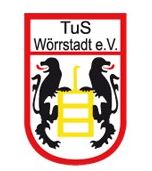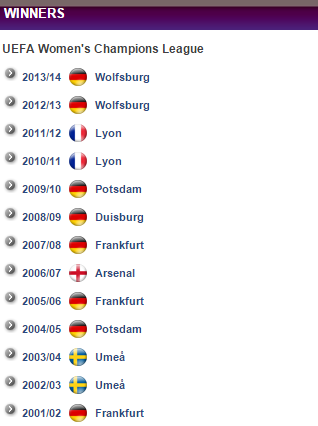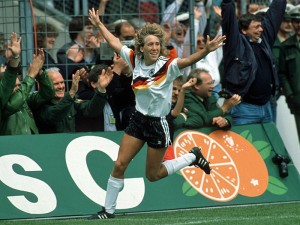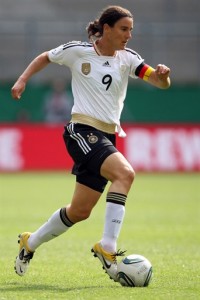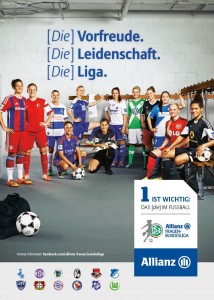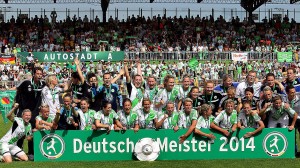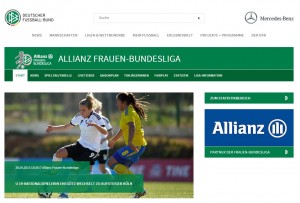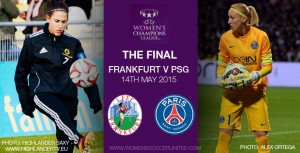by Justin Fu
Published in May 2015
Back to 2015 Women’s World Cup Guide
Back to Women’s Professional Leagues in Notable Countries
Back to United States: National Women’s Soccer League
Go onto Japan: L. League
INTRODUCTION AND FIFA RANKINGS OF NATIONAL TEAM
The Allianz Frauen-Bundesliga or Frauen-Bundesliga, for short, is one of the premier women’s domestic professional football leagues in the world. With a history that spans over 25 years and a host of strong domestic players, the Frauen-Bundesliga features some of the world’s best football and players. The league’s website describes the league as “the image bearer for German women’s football. The elite class has established itself as a brand, with faces and stories to remember” (“Allianz Frauen-Bundesliga”). This page will delve into the history, format, and current news of the league that is the backbone of the national team, which is currently ranked #1 in FIFA’s World Rankings (“The FIFA Women’s World Ranking – FIFA.com”).
More information about the German Women’s National Team from the Soccer Politics Blog can be found here.
HISTORY OF THE LEAGUE
Early Beginnings
Women’s football was long frowned upon in Germany. The game was considered a “man’s game” that involved such brutality that it seemed unfit for a young boy, let alone a woman. However, the 1960s brought about social revolutions that increased women’s levels of education and labor rights. At this point, women were no longer considered the “weaker sex,” but instead as equals to men. This trend carried over to the world of sport, and the German Football Association (DFB) could no longer sit idly by. Initially, the DFB’s Games Supervisory Committee developed unique rules to the women’s game that shortened the halves, removed studded boots, used a youth sized football ball, and removed apparel advertising that supposedly drew the spectators’ eyes to the players’ bosoms (Pfister 101). Nevertheless, female football in Germany had begun to garner support from the DFB.
As early as 1974, a German national championship between TuS Worrstadt and DJK Eintracht Erle was played (“Historie”). It marked an early milestone of women’s football in the Bavarian nation. Throughout the 1980s, club leagues were introduced on a regional level in West Germany, through which the best players and teams would be selected to play in the national championship. In East Germany, national resources were invested into athletes and sports with the greatest chance of winning at the Olympic Games. The women’s game spread quickly on a local level throughout the 1980s in East Germany as well. However, the 1980s also witnessed significant financial and political obstacles to the development of the women’s game. The unification of East and West Germany allowed the establishment of a unified league in 1990 and the growth of the women’s game would skyrocket henceforth (Pfister 103).
The Birth and Growth of the Frauen-Bundesliga
The DFB first established the Frauen-Bundesliga in 1990, making it the first ever women’s professional league in Germany (Pel). The league was originally founded by 20 member clubs, but since the league’s birth, the structure of the league has changed significantly. Among the 20 founding members, only a few have remained in the top flight for the league’s entire history: SG Praunheim (1. FFC Frankfurt’s former outfit until 1999) and FC Bayern Munich are among these teams. The uncertainty that many clubs faced in the early years of the league has since passed, as the league is in its 25th season and has become a vibrant part of the local football landscape of Germany.
The league has grown greatly over the years and changed in its own respect to reflect the increasing popularity and visibility of the women’s game. In 1993, the playing time for each half was increased to 45 minutes as opposed to the previous 40 minute halves. The original structure of the league consisted of a separate north and south divisions with 10 teams in each division, but the league was united in 1997 to form a single league comprised of 12 teams (“Frankfurt and Birgit Prinz the Stars”). The structure of the league has remained the same ever since this merger. The German Football Association has also introduced a B-youth league for the 2012/2013 season, helping to develop youth talent at a higher level (“Historie”).
Large vs. Small Clubs
The Frauen-Bundesliga began in an era where teams from the smaller towns dominated. TSV Siegen, a small, university town in the North Rhine-Westphalia state, won four out of the first six trophies (“Sportfreunde Siegen”). However, in recent memory larger cities such as Frankfurt, Munich, Hamburg and Duisburg have dominated the competition (“Frankfurt and Birgit Prinz the Stars”). The rise of large clubs reflects a growing investment from strong men’s clubs teams into partnering women’s clubs. However, traditional winners such as 1. FFC Frankfurt and 1. FFC Turbine Potsdam still remain the strongest perennial teams. Furthermore, the relegation structure allows smaller clubs from the 2. Bundesliga to rise and gain entry into the Frauen-Bundesliga.
UEFA Success
German clubs on both the men and women’s sides have a storied history in UEFA Cups and Champions Leagues competitions. Since the 2002 inaugural UEFA Women’s Champions League season, only three winners have not hailed from a German side (“UEFA Women’s Champions League – History – UEFA.com”). All other winners represent a German club in the Frauen-Bundesliga. Wolfsburg (2013, 2014) , Potsdam (2005, 2010), and 1. FFC Frankfurt (2002, 2006, 2008) have all won multiple times since the first Champions League competition, with Duisburg being crowned champions in its 2009 campaign. This makes the Frauen-Bundesliga the most successful league in the UEFA Women’s Champions League with seven titles won by four clubs. German women’s success at the Champions League stage demonstrates the strength of the domestic league compared to other strong footballing powers in Europe. You can read more about the UEFA Women’s Champions League history here (“UEFA Women’s Champions League – History – UEFA.com”).
Notable Players of the Frauen Bundesliga
Some of the most successful women’s football players in the world have played in the German Frauen-Bundesliga. One of the league’s original stars in the 1990s was Heidi Mohr, having appeared on the national team 104 times (“Heidi Mohr”). Mohr was the top scorer in the Bundesliga for 5 consecutive years from 1991 through 1995. Mohr played in the Frauen-Bundesliga for TuS Ahrbach, TuS Niederkirchen, and 1. FFC Frankfurt. Mohr’s domestic league domination was accentuated on the national team, as she has a record 0.80 goals per game average (83 goals over 104 games) and is the second leading scorer of all time, following legend Birgit Prinz.
Birgit Prinz had a storied career in the Frauen Bundesliga, scoring 155 goals in the league as the fourth all-time goal-scorer (“Birgit Prinz”) (“Statistics”). She started her career at SV Dornigheim and eventually debuted for FSV Frankfurt in the Bundesliga in 1993. She won two Bundesliga titles and two German cups during her five year stay at FSV Frankfurt. In 1998, she moved to 1. FFC Frankfurt. Over a total 13 year stay at the club, she won six Bundesliga titles and eight German cup titles. She also won the UEFA Women’s Champions League three times with Frankfurt (2002, 2006, and 2008). She was also named FIFA World Player of the YEAR in 2003, 2004 and 2005. She was also named the German Female Footballer of the Year from 2001 to 2008 (“Birgit Prinz”).
For more information on notable German players from other writers on the Soccer Politics Blog, please visit here.
Allianz Sponsorship
For the 2014/2015 season, the Frauen-Bundesliga will be known as the Allianz Frauen-Bundesliga through a new partnership with Allianz, a German multinational financial services company headquartered in Munich (“Allianz”). The partnership will last for five years until the 2019 season. According to the DFB President Wolfgang Niersbach:
“This agreement is a milestone in the development of women’s football and especially the women’s Bundesliga. We therefore allowed a partner for the first time the naming rights to one of our leagues because the clubs directly benefit from the money.. flowing into the coffers of the clubs, which can thus develop their gaming operations in the future. This partnership is a clear commitment to women’s football in the form of unique in the world. ” (“Partner”)
Specifically, each club can expect €100,000 of income from the sponsorship (Hellmann). In return, clubs are required to feature the Allianz logo on the sleeves of all jerseys, interview zones, and surrounding stadium barricades (“Novum Im Deutschen Fußball: Allianz Wird Namenssponsor Der Frauen-Bundesliga” ). The clubs will continue their participation in the Alliance Girls Cup, which started in 2010, and features approximately 16,000 footballers ranging from the age groups of U11 to U17 and older. The landmark deal with Allianz is a watershed moment for the league and women’s football development from a financial perspective.
FORMAT/RULES
Regular Season Schedule
The Allianz Frauen-Bundesliga currently runs from August/September to May/June (“Spieltag/Tabelle”). Schedules may be adjusted to accommodate World Cups or Olympic Games, during which the league would assign a month of rest. In each round, every club plays against each other, with a home game in one round and an away game in the other. The first round typically starts in late August or September and finishes in December, while the second round starts around February and ends in May or June. In total, there are 22 match days over the course of the entire season. After the last match day of the season is played, the team with the top standing is awarded the title of “Deutcher Meister” as champion of the league. The champion of the league represents the Frauen-Bundesliga in the UEFA Women’s Champions League along with the runner-up of the league.
Teams
The Frauen-Bundeliga currently consists of 12 teams. To compete in the league, every club is required to receive a DFB license from the league. The license is awarded based on the club’s “legal, personnel, administrative, infrastructural, safety-related, media, and financial criteria” (“Frauen-Bundesliga”). Specifically, the financial criteria is evaluated to ensure that clubs can support a club in the league. Since the founding of the league in 1990, clubs have never filed for insolvency or withdrawn teams due to financial pressures. This contrasts greatly with the many women’s leagues of the United States that have failed due to financial insolvency. A table of the current teams can be found below.
| Club | Home City | City Population* |
|---|---|---|
| MSV Duisburg | Duisburg | 486,855 |
| SGS Essen | Essen | 569,884 |
| 1. FFC Frankfurt | Frankfurt | 701,350 |
| Sport-Club Freiburg | Freiburg | 218,043 |
| Herforder SV Borussia Friedenstal | Herford | 65,333 |
| TSG 1899 Hoffenheim | Hoffenheim | 3,272 |
| FF USV Jena | Jena | 107,679 |
| Bayer 04 Leverkusen | Leverkusen | 160,819 |
| FC Bayern Munchen | Munich | 1,407,836 |
| 1. FFC Turbine Potsdam | Potsdam | 159,456 |
| SC Sand | Willstatt | 9,213 |
| VfL Wolfsburg | Wolfsburg | 122,457 |
*Population data from Wikipedia.org
Relegation
The league also includes relegation and promotion rules as the clubs finishing 11th and 12th are replaced with the top teams of the two 2. Bundesliga divisions. The 2. Bundesliga or the 2nd Women’s Football Bundesliga is the second tier league for women’s football in Germany and is divided into 2 divisions: North and South. Winners of each group get promoted to the Frauen-Bundesliga, while the last two places of each group are relegated to the Regionalliga. This relegation structure allows for successful, small teams to represent themselves on the premier tiered league, the Frauen-Bundesliga. This club movement is shown in some teams that have village-like populations as shown in the table above.

The 12 teams currently competing in the Frauen-Bundesliga are spread across the country. However, these are subject to change due to relegation from season to season.
WOMEN’S PROFESSIONAL LEAGUES VS. MEN’S PROFESSIONAL LEAGUES
Salaries and Team Finances
Since the Frauen-Bundesliga is a semi-professional league, the salaries of players across the board are quite low. Most players must support themselves with secondary sources of income in addition to their income from football, and many players are also students. Due to the semi-professional nature of the league, player salaries do not exceed those of the National Women’s Soccer League in the United States. However, the national players, who are generally considered the stars of the league, have higher salaries than other players (Leeds 375).
Clubs currently receive €180,000 a year from the DFB through the various sponsorship and broadcasting deals (Owen). However, the total amount that clubs receive can vary greatly, depending on the size and prominence of the club. For example, the top three clubs in the Frauen-Bundesliga, 1. FFC Frankfurt, VfL Wolfsburg, and 1. FFC Turbine Potsdam, can have budgets that are on the order of €2 million. While the disparity between clubs financially is large, the baseline level of support that clubs receive from the DFB is necessary for some smaller clubs’ livelihood in the league (Owen).
As a point of reference, a study conducted by Sportsmail revealed that the average player salary per year for a male player in the Bundesliga is over €2 million (Harris). These astronomical numbers indicate the gaping disparity between the male and female leagues. Essentially, the average male player in the Bundesliga is able to net a paycheck that is on par with the entire budget of some of the most successful Frauen-Bundesliga teams. Furthermore, the average club income per year for Bundesliga teams comes in at around €125 million (Harris).
Attendance and Stadiums
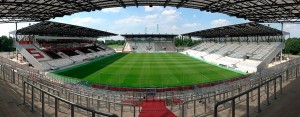
The Stadion Essen (Essen Stadium) is currently the largest stadium that hosts Frauen-Bundesliga matches.
Attendance at league matches has grown significantly over time (“Frankfurt and Birgit Prinz the Stars”). At the start of the league, games would often struggle to garner over 200 spectators. However, in the 2006/2007 season, the league averaged over 700 spectators per game. Currently, games involving two average team easily draw over 1,000 fans, and more popular teams can attract over 5,000 spectators. Most notably, the greatest increases in spectatorship in the league has followed FIFA Women’s World Cup Years (2003, 2007, 2011).
The stadium capacities and names are listed below (ordered by capacity):
| Club | Stadium Name (City) | Capacity* |
|---|---|---|
| SGS Essen | Essen Stadium (Essen) | 20,650 |
| Herforder SV Borussia Friedenstal | Ludwig-Jahn Stadium (Herford) | 18,400 |
| Sport-Club Freiburg | Moslestadion (Freiburg) | 18,000 |
| VfL Wolfsburg | VfL Stadium on Elsterweg (Wolfsburg) | 17,600 |
| FF USV Jena | Ernst-Abbe-Sportsfield (Jena) | 12,630 |
| 1. FFC Turbine Potsdam | Karl-Liebknecht Stadium (Potsdam) | 10,499 |
| FC Bayern Munchen | Grunwalder Stadium (Munich) | 10,240 |
| TSG 1899 Hoffenheim | Dietmar Hopp Stadium (Hoffenheim) | 6,250 |
| FC Bayern Munchen | Stadium on Brentanobad (Frankfurt) | 5,500 |
| Bayer 04 Leverkusen | Ulrich-Haberland Stadium (Leverkusen) | 3,200 |
| MSV Duisburg | PCC Stadium (Duisburg) | 3,000 |
| SC Sand | Kuhn Matt Stadium (Willstatt) | 2,000 |
*Table information from Wikipedia.org
Men’s Bundesliga matches experience the highest attendance rates of any football league in the world, averaging over 42,000 fans per game in a season, according to a Sportsmail study (Harris). Furthermore, the average attendance of Bundesliga matches is only second to America’s National Football League (NFL) for all professional sports leagues in the world. While the immense gap in attendance numbers for women’s and men’s Bundesliga matches is alarming, the upward trend in the women’s games is encouraging and expected to grow this year, with the onset of the 2015 Women’s World Cup.
International Flair
Both the Frauen-Bundesliga and the men’s Bundesliga can be considered top tier leagues in their own respects, and as such, they attract players from many different countries. Additionally, the Bosman ruling removes restrictions from foreign EU players within the league, and allows them to move between clubs without transfer fees. While the majority of each roster remains German, most clubs feature a few international players. However, the number of non-EU players has been restricted at the beginning of the 2006/2007 season from five to three per roster. Currently only 10% of the league are non-German (“Frankfurt and Birgit Prinz the Stars”). While some attribute the number of international players in a league to the success of the league, others claim that a league must allow for domestic development of its country’s players. The ruling to reduce non-EU players on Frauen-Bundesliga rosters reflects a shift to develop domestic prospects in the women’s game, a task that has paid dividends in their FIFA rankings.

Kozue Ando plays for 1. FFC Frankfurt and the Japanese national team, having found success on both squads.
The men’s Bundesliga features a high number of foreign players, as the limits on non-EU players were lifted for the 2006/2007 season (“Foreign Football Players in Germany”). However, a UEFA local player ruling was introduced, which required that a certain number of locally-produced players must be enrolled at each club (“More Room for Foreigners in Bundesliga”). The current quota is 8 home-grown players, and at least 4 youth players from the team’s youth academy must be registered to the Bundesliga team. The caveat is that the DFB does not set a limit on the maximum number of players registered per season, allowing teams to roster an excess of players to satisfy the rules and their usage of international talents (Swarbrick). In 2010, the percent of foreign players was at 45% of the league, reflecting the attractiveness of the league to players who are unable to be added to a roster in more restrictive leagues (“Foreign Football Players in Germany”).
Websites
Both the Frauen-Bundesliga and the men’s Bundesliga feature websites that prominently display each league’s activity. On the main DFB website, all leagues are filed under a “Leagues and Competitions” tab that subdivides the plethora of German leagues into various age and gender groups. Both league pages are equally accessible from this menu.
The Frauen-Bundesliga webpage features several tabs: “News”, “Matchday/Table”, “Live Scores”, “Season Schedule”, “Scorer Interior”, “Fair Play”, “Statistics”, and “League Information.” These tabs dive into various league aspects that shows the commitment of the DFB and the league to popularize the sport through online media. The men’s league webpage features similar tabs, with only a few additional ones detailing player suspensions and relegation scheduling. Overall, there are no stylistic or substantive differences between the two webpages and their content.
RELATIONSHIP TO NATIONAL TEAM
Performance of National Team
The German women’s national football team is one of the most successful women’s team, having won the 2003 and 2007 FIFA Women’s World Cup (“FIFA Women’s World Cup Final”). After winning the World Cup in 2003, the national team was selected as Germany’s Sports Team of the Year, inspiring a new wave of popularity nationwide (“German Sportspersonality of the Year”). In response to this victory, praise was heard from DFB’s president, Gerhard Mayer-Vorfelder, and the German chancellor and president both sent their congratulations to the team. FIFA president Joseph Blatter even claimed that the event marked “a new dimension, tremendous progress, and football of the highest order.” (Pfsiter, 104)

Joseph “Sepp” Blatter, FIFA president, had kind and inspiring words for the 2003 German national women’s team after their championship run.
Players
The players of the Frauen-Bundesliga enjoy the support of their federation through training, coaching, and salaries. Furthermore, the relationship between league and federation extends to player development, marketing, training techniques, and even tactics (Pel). Of the 21 players on the current squad, only four players are playing outside of Germany for their club side. Of the 17 players on the national team playing in the Frauen-Bundesliga, there are five playing for 1. FFC Frankfurt and three players for both FC Bayern Munich and VfL Wolfsburg (“German Women’s National Football Team”).
Coaching
Coaching has been a hot-button topic of late, as more and more female coaches are being replaced by male coaches. Germany’s women’s national team coach is Silvia Neid, a retired national team player, and has been able to manage the team successfully at the top level (“German Women’s National Football Team”). She will be stepping down in 2016 and Steffi Jones, also a retired German female footballer, will take her coaching job (“Silvia Neid Set to Retire, Steffi Jones to Take Over”). Another example of strong female coaches on the German women’s national team is Tina Theune-Meyer, who in 1996 became the first woman to take over this position. Her victory in the 2003 World Cup made her the first woman in the world to lead a football team to the title. Despite these successes, very few coaches across the league are female as they do not represent a majority of coaches. (Pfister, 106)
More information about the German Women’s National Team can be found here.
CURRENT EVENTS
Current Standings
The 2014/2015 Frauen-Bundesliga season is drawing to a close, with only the final round of games remaining. The current Frauen-Bundesliga standings are shown in the table below:
The table reflects the latest round of matches played on April 26 (“Spieltag/Tabelle”). On this match day, VfL Wolfsburg secured a 4-0 victory over SGS Essen and 1. FFC Frankfurt also defeated 1899 Hoffenheim, 4-0. Bayern Munich was also unchallenged in a 6-0 victory over Herforder SV. This leaves the 22nd and final week of action to decide the champion of the league as 1. FFC Frankfurt and VfL Wolfsburg will face off in Frankfurt on May 10th. The winner of this match will reign as champions of the Frauen-Bundesliga, but if there is a draw, Bayern Munich can secure the top spot with a win of their own. Frauen-Bundesliga fans have one final, gut-wrenching week of matches to watch before this season is concluded.
UEFA Women’s Champions League
On May 14, 2015, the final of the UEFA Women’s Champions League will be played, as Paris Saint-Germain will take on 1. FFC Frankfurt. 1. FFC Frankfurt will play in their record sixth final in Berlin, and will be considered the heavy favorites, having won the title three times before. This is the eighth final in a row that will feature a German side, and the 12th time overall in the history of the competition. This will be the first UEFA Women’s Championship held in Berlin at the Friedrich-Ludwig-Jahn-Sportpark Stadium. On the precipice of the 2015 Women’s World Cup, the eyes of the female footballing community will be on Berlin to see if PSG can prevail over the titans that are 1. FFC Frankfurt.
Sources:
- “Allianz Frauen-Bundesliga.” DFB. Deutscher Fussball-Bund, 18 Mar. 2014. Web. 29 Apr. 2015. <http://www.dfb.de/allianz-frauen-bundesliga/start/>.
- “The FIFA Women’s World Ranking – FIFA.com.” com. FIFA, 27 Mar. 2015. Web. 29 Apr. 2015. <http://www.fifa.com/fifa-world-ranking/ranking-table/women/index.html>.
- Pfister, Gertrud; Tomlinson, Alan. “6. The Future of Football Is Female!? On the past and Present of Women’s Football in Germany.” German Football: History, Culture, Society. London: Routledge, 2006. Print.
- “Historie.” DFB. 27 Nov. 2013. Web. 29 Apr. 2015. <http://www.dfb.de/allianz-frauen-bundesliga/liga-information/historie/>.
- Pel, Jenna. “German Pro League Brings Success.” ESPN. ESPN Internet Ventures, 18 June 2011. Web. 29 Apr. 2015. <http://espn.go.com/espnw/news/article/6670374/women-world-cup-german-pro-league-brings-success>.
- “Frankfurt and Birgit Prinz the Stars.” com. Web. 29 Apr. 2015. <http://www.fifa.com/womensworldcup/destination/footballgermany/dfb.html>.
- “Sportfreunde Siegen.” Wikipedia. Wikimedia Foundation, 15 Mar. 2015. Web. 29 Apr. 2015. <http://en.wikipedia.org/wiki/Sportfreunde_Siegen#Women.27s_football>.
- “UEFA Women’s Champions League – History – UEFA.com.” com. UEFA, 16 June 2010. Web. 29 Apr. 2015. <http://www.uefa.com/womenschampionsleague/history/index.html>.
- “Heidi Mohr.” Wikipedia. Wikimedia Foundation, 5 Sept. 2014. Web. 29 Apr. 2015. <http://en.wikipedia.org/wiki/Heidi_Mohr>.
- “Birgit Prinz.” Wikipedia. Wikimedia Foundation, 26 Apr. 2015. Web. 29 Apr. 2015. <http://en.wikipedia.org/wiki/Birgit_Prinz>.
- “Statistics.” Allianz Frauen-Bundesliga. DFB, 27 Apr. 2015. Web. 29 Apr. 2015. <http://www.dfb.de/allianz-frauen-bundesliga/statistik/rekordtorjaegerinnen/?no_cache=1>.
- “Allianz.” Wikipedia. Wikimedia Foundation, 27 Apr. 2015. Web. 29 Apr. 2015. <http://en.wikipedia.org/wiki/Allianz>.
- “Partner.” DFB. 27 Nov. 2013. Web. 29 Apr. 2015. <http://www.dfb.de/allianz-frauen-bundesliga/liga-information/partner/>.
- Hellmann, Frank. “DFB Frauen-Bundesliga Sponsor: Eine Starke Allianz.” DFB Frauen-Bundesliga Sponsor: Eine Starke Allianz. 10 Apr. 2014. Web. 29 Apr. 2015. <http://www.fr-online.de/ffc-frankfurt/dfb-frauen-bundesliga-sponsor-eine-starke-allianz,1473454,26812948.html>.
- “Novum Im Deutschen Fußball: Allianz Wird Namenssponsor Der Frauen-Bundesliga.” Handelsblatt Online Newspaper. Handelsblatt, 4 Oct. 2014. Web. 29 Apr. 2015. <http://www.handelsblatt.com/sport/fussball/novum-im-deutschen-fussball-allianz-wird-namenssponsor-der-frauen-bundesliga/9743664.html>.
- “Spieltag/Tabelle.” DFB. 18 Mar. 2014. Web. 29 Apr. 2015. <http://www.dfb.de/allianz-frauen-bundesliga/spieltagtabelle/?no_cache=1>.
- “Frauen-Bundesliga.” Wikipedia. Wikimedia Foundation, 20 Feb. 2015. Web. 29 Apr. 2015. <http://de.wikipedia.org/wiki/Frauen-Bundesliga>.
- Leeds, Michael. “The Economic Impact of the Women’s World Cup.” Handbook on the Economics of Women in Sports. Northampton: Edwar Elgar, 2013. Print.
- Owen, David. “Women’s Football Looks for Chance to Broaden Appeal – FT.com.” Financial Times. 1 Dec. 2014. Web. 29 Apr. 2015. <http://www.ft.com/intl/cms/s/0/0c34da84-637b-11e4-8a63-00144feabdc0.html#axzz3YRsB6SrX>.
- Harris, Nick. “Premier League Wages Dwarf Those around Europe with Top-flight Players in England Earning an Average of £2.3million a Year… Almost 60 per Cent More than in Germany.” Mail Online. Associated Newspapers, 15 Nov. 2014. Web. 29 Apr. 2015. <http://www.dailymail.co.uk/sport/football/article-2833020/Premier-League-wages-dwarf-Europe-flight-players-England-earning-average-2-3million-year.html>.
- “Foreign Football Players in Germany.” Wikipedia. Wikimedia Foundation, 23 Aug. 2014. Web. 29 Apr. 2015. <http://en.wikipedia.org/wiki/Foreign_football_players_in_Germany>.
- “More Room for Foreigners in Bundesliga.” 1 Aug. 2006. Web. 29 Apr. 2015. <http://www.dw.de/more-room-for-foreigners-in-bundesliga/a-1849734>.
- Swarbrick, Silas. “Does the Bundesliga Need to Limit Foreign Transfers?” Bundesliga Fanatic. 12 Dec. 2014. Web. 29 Apr. 2015. <http://bundesligafanatic.com/does-the-bundesliga-need-to-limit-foreign-transfers/>.
- “FIFA Women’s World Cup Final.” com. Web. 29 Apr. 2015. <http://www.fifa.com/tournaments/archive/womensworldcup/>.
- “German Sportspersonality of the Year.” Wikipedia. Wikimedia Foundation, 26 Dec. 2014. Web. 29 Apr. 2015. <http://en.wikipedia.org/wiki/German_Sportspersonality_of_the_Year>.
- “German Women’s National Football Team.” Wikipedia. Wikimedia Foundation, 27 Apr. 2015. Web. 29 Apr. 2015. <http://en.wikipedia.org/wiki/Germany_women’s_national_football_team#Current_squad>.
- “Silvia Neid.” Wikipedia. Wikimedia Foundation, 26 Apr. 2015. Web. 29 Apr. 2015. <http://en.wikipedia.org/wiki/Silvia_Neid>.
- “Silvia Neid Set to Retire, Steffi Jones to Take over | Sports | DW.DE | 30.03.2015.” DE. 3 Mar. 2015. Web. 29 Apr. 2015. <http://www.dw.de/silvia-neid-set-to-retire-steffi-jones-to-take-over/a-18349413>.
How to cite this page (MLA): Fu, Justin. “Germany: Allianz Frauen-Bundesliga.” Soccer Politics: The Politics of Football. Duke University, 1 May 2015. Web. (Date accessed). <http://sites.duke.edu/wcwp/world-cup-guides/world-cup-2015-guide/womens-professional-leagues-in-notable-countries/womens-professional-leagues-in-notable-countries-germany/>.
Back to 2015 Women’s World Cup Guide
Back to Women’s Professional Leagues in Notable Countries
Back to United States: National Women’s Soccer League
Go onto Japan: L. League


